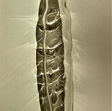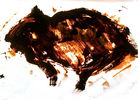Marcus Wood
GRUB

Xyleuties Leucochla Turner, the witchetty grub a large white grub which infests the roots of the acacia shrub of the Australian bush and outback.
My Project saw the grub as a point of trauma and a point of healing, and the various art and performances were aimed at its reintegration into Australian cultural life.
For the white settler communities the Grub was always an object of disgust and ridicule. Pesticides destroyed it, it became a 'bush tucker' jest, a hefty Germaine Greer gamely ingested one in I'm a Celebrity get me out of here. Kids at holiday camp held them and screamed. Confectionary companies have turned the grubs into cheap sweets to rot the teeth of the poor obese children of the suburbs.
The witchetty grub hatches from an egg and tunnels underground. It spins a silk cocoon which holds it next to the root of an acacia bush, and latches onto the root feeding on sap. After two or three years, when it is the size of a corrugated chipolata sausage, the grub turns into a giant cossid moth, and climbs up through a silk lined tunnel to the surface. These moths cannot eat anything, their mouth parts do not work, and they only have the food stored in their bodies as grubs to live on. The moths have two things to do, mate and lay eggs. This takes a week or so then they die. The eggs hatch, and the cycle begins again.
The fact that the grub has to store up all the food it will ever get as an adult moth means that it is solid protein. Protein was very hard for the Aboriginals to find, and the grub was a special food for many of them. The grub was also sacred. The Arunta people performed ceremonies for multiplying the grub. One was a performance acting out the change of the grub into the moth. A long narrow structure of twigs was set up to imitate the chrysalis case of the grub. Inside this twig shell the grub men sat and then shuffled out, singing of the grub coming from the darkness to the light, and going from the light into the darkness.
RAINBOW GRUB HEART OF GLASS
Insects of Australia, Vol. 1 CSIRO Australia, Melbourne UP 1991, Chapter 9 D. F. Waterhouse, Insects and Humans in Australia, p. 221-3.
Aborigines had little means of storing food and this exposed them to irregular and sometimes prolonged periods of food shortage. At times insects may have been the only available food, a number of insects are represented in Aboriginal religion as totems and special ceremonies were performed to promote their abundance. Among the highly prized were a number of species of Witchetty Grub. Witchetty grubs continue to this day to be a much sought after delicacy among tribal Aborigines. Wijuti or Witchety (often misspelt as Witchetty) is the Arabana word for the Acacia shrubs on the roots of which the mako or grubs of the Cossid moths feed…In the deserts of South Australia the main species of witchety grub is the larva of Xyleuties Leucochla which reaces a size of 8 c.m. towards the end of its two year life cycle. The larvae feed internally within a silk lined tunnel, on the roots of Acacia Ligulata eating sparingly of the wood and relying mostly on the flow of sap from root wounds kept open and fresh. The larva maintains a tunnel to the ground surface inside which the pupa ascends, piercing the lid of the tunnel just before emergence. The rising of the pupae enables Aborigines to gather large quantities of food without the labour of digging deep into the soil to obtain the larva in the feeding stage. The larva are often eaten raw or perhaps cooked by gently rolling them in the warm ashes of a fire. When raw they are said to taste somewhat like scalded cream and when cooked , like the rind of roast pork or bone marrow. Women and children spend much time digging for the larvae and babies may often be seen with one dangling from the mouth.

Film 'Marcus Wood Grub' the film shows the major performances in Canberra focused on the giant Grub
FLIGHT BURIAL AND APOTHEOSIS OF THE GRUB
William Blake Vala or the Four Zoas from book 9
'Let the slave grinding at the mill run out in to the field;
Let him look up into the heavens and laugh in the bright air;
Let the enchained soul, shut up in darkness and in sighing,
Whose face has never seen a smile in thirty weary years,
Rise and look out - his chains are loose, his dungeon doors are open…
The good of all the land is before you for Mystery is no more!'…
Then all the slaves from every earth in the wide universe
Sing a new song, drowning confusion in its happy notes
Then fell the legions of Mystery in maddening confusion
Down, down, through the immense, with outcry, fury & despair
Into the winepresses of Luvah. Howling fell the clusters
Of human families through the deep. The winepresses were filled
The blood of life flowed plentiful, odours of life arose...
Timbrels and violins sport around the winepresses. The little seed,
The sportive root, the earthworm, the small beetle, the wise emmet
Dance round the winepresses of Luvah. The centipede is there,
The ground spider with many eyes, the mole clothed in velvet,
The earwig armed, the tender maggot, emblem of immortality,
The slow slug, the grasshopper that sings and laughs and drinks -
The winter comes, he folds his slender bones without a murmur -
There is the nettle that stings with soft down, & there
The indignant thistle whose bitterness is bred in his milk
And who lives in the contempt of his neighbour; there all the idle weeds
That creep about the obscure places show their various limbs
Naked in all their beauty, dancing round the winepresses.
They dance around the dying & they drink the howl and groan...

GRUB EXHIBITION INSTALLATI0N AND SELECTED PERFORMANCES

GRUB EXHIBITION A.N.U. SCHOOL OF ART CANBERRA
This exhibition had the giant Wijuti Grub, coated in marble dust and gold and sliver leaf as its centre piece. This was a sort of lying in state for the Grub before it went off on its final filght, and then through death to burial, which was its rebirth. Its resurrection is imminent.
Around the Grub installation on the floor were hung my paintings the two big oils of the rainbow grub and the adult cossid moth in flight. There was a small installation of white chocolate grubs which had been pinned in an entomological case, and a rope grub woven for the show by the world's leading rope expert the wonderful Des Pawson. The glass grubs were suspended from the ceiling, one a black chrysalis the other the glass rainbow grub made from my designs by Lene Lunde, Swedish glass blower and sculptress, a beautiful person in body and in soul. The final images in this section show the limestone and brass plaque which mark the resting place of the Grub in the National Sculpture Garden in Canberra, a work entitled 'Invisible Sculpture Built not to Last or Contaminate'
OCEANIC TAR BABIES
While in Australia I continued to make tar paintings of animals, by now I saw the tar babies as a growing family, based on great chain of being. I became fascinated with Australia's vast spiders several species of which I painted. I also became interested in their particularly blood thirsty ticks.
At the centre of it all was the Rainbow Grub, this mural sized painting was the only time I have ever mixed oil paint with tar. The paintings disappeared into the collection of Stephanie Burns, I have no idea of their precise location today. I always loved the idea that ones best work can just go walkabout. Manet's best version of the Execution of Maximilian did after all reputedly get cut up to patch up the roof of a pub.


















































